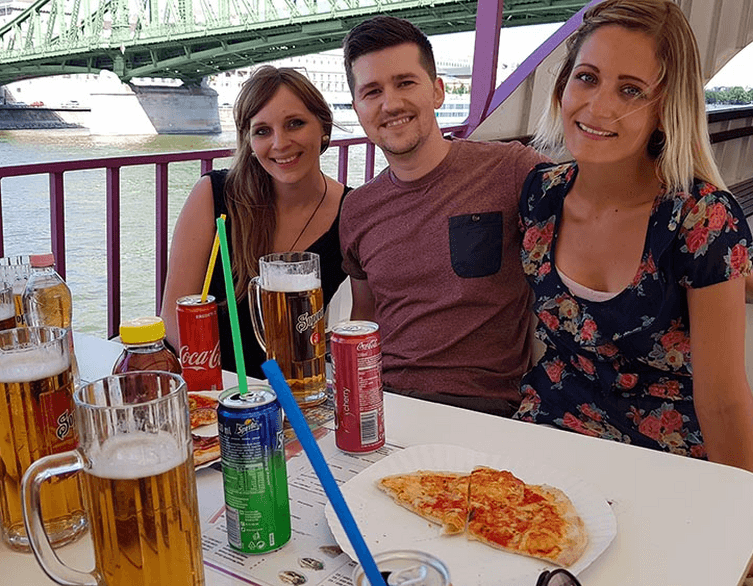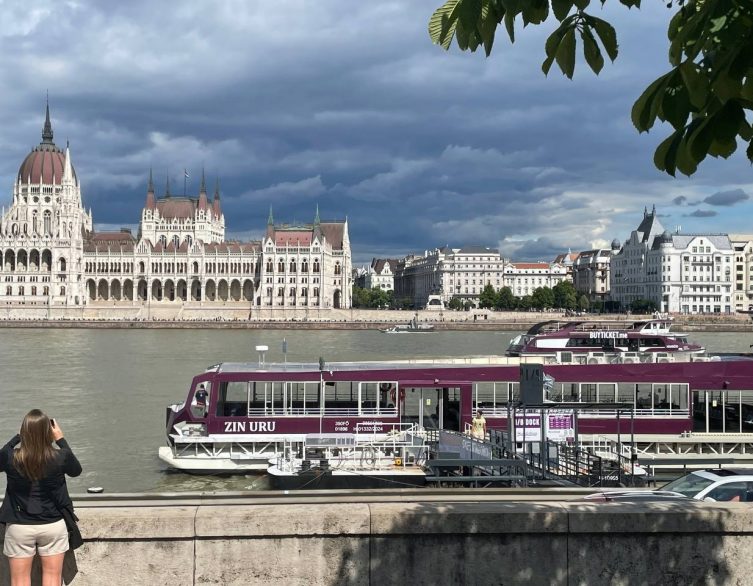Public Transportation in Budapest
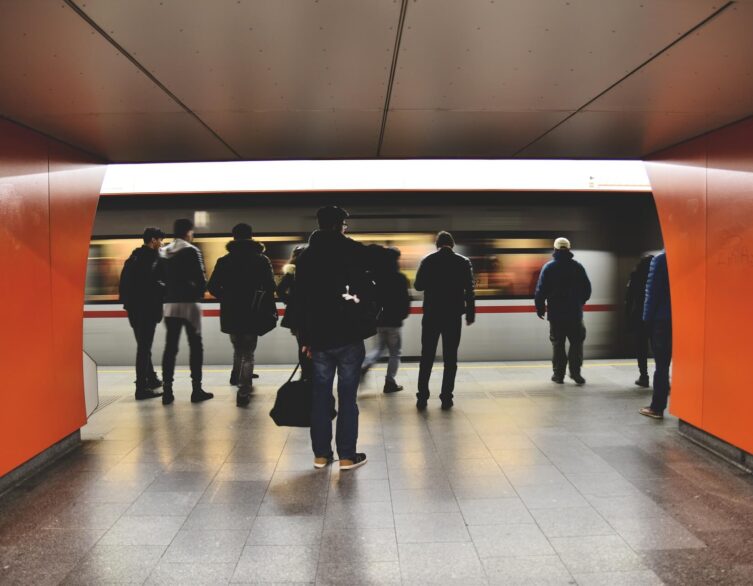
Budapest has an extensive and efficient public transportation system that makes it easy to get around the city. The network includes buses, trams, trolleybuses, and metro lines that cover most areas of the city. The public transportation company, BKK, has put together a handy booklet specially made for travelers visiting the beautiful city of Budapest. This booklet helps visitors in finding their way around the city and to explore which transportation options would work best for them.l
The metro system in Budapest is the oldest electrified underground railway system on the European continent, and the second-oldest electrically operated underground railway in the world. It consists of four lines (M1, M2, M3, and M4) that connect the suburbs with the city center. The iconic Line 1, or M1, dates back to 1896 and is a UNESCO World Heritage Site.
Trams are also a popular way to travel, with over 30 lines running throughout Budapest. Many of the trams run 24 hours a day. The city’s tram network is one of the largest in the world.
Buses fill in the gaps between the metro and tram lines. There are over 200 bus routes in Budapest, including express and night services. Trolleybuses, which are electric buses connected to overhead wires, operate on over a dozen lines as well.
Tickets for public transportation can be purchased at metro stations, newsstands, and ticket vending machines. Passengers must validate their tickets when boarding. Travelcards providing unlimited rides within a set time period are also available.
With its comprehensive, reliable, and affordable public transportation system, it is easy for both locals and tourists to navigate their way around Budapest. The metro, trams, and buses provide convenient access to all the major landmarks, attractions, and neighborhoods in this beautiful city.
Fares and Passes for Public Transportation in Budapest
Budapest’s public transportation system offers a variety of fares and passes to cater to the needs of foreign tourists. By understanding the options available, such as ticket vending machines, mobile tickets, and discounts, visitors can make the most of their travel experience in the city. Whether opting for single tickets, travelcards, or longer-term passes, tourists can easily navigate Budapest’s extensive network of buses, trams, trolleybuses, and metro lines, making their stay in the Hungarian capital both enjoyable and hassle-free.
Ticket Vending Machines (TVMs)
One of the most convenient ways to purchase tickets and passes for Budapest’s public transport system is through Ticket Vending Machines (TVMs). These machines are located at various transport hubs and stops throughout the city, including metro stations and suburban railway stations. TVMs operate 24/7 and accept both cash (coins and banknotes) and bank cards (contact and contactless). The machines have a user-friendly, multilingual touchscreen interface that makes the purchasing process simple and quick. It is important to note that TVMs do not issue receipts, as the tickets and passes themselves serve as proof of purchase.
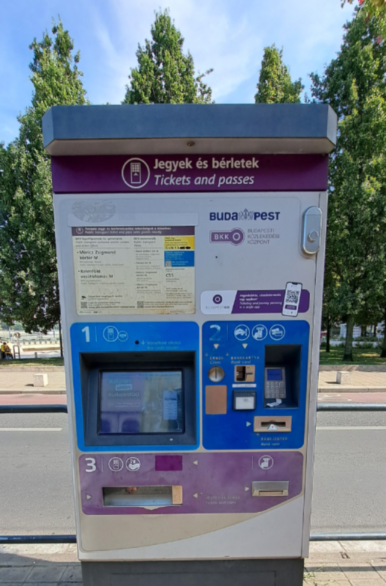
Mobile Tickets
In addition to physical tickets and passes, Budapest also offers mobile ticketing options through various smartphone applications. These apps allow users to purchase and store tickets and passes on their mobile devices, eliminating the need to carry physical copies. To use a mobile ticket, travelers simply need to scan the displayed QR code or hold their phone near the NFC sticker when boarding a vehicle or entering a metro station. An active mobile data connection is required for purchasing and using mobile tickets.
What are Mobile Tickets: Mobile tickets are digital versions of traditional paper tickets that can be purchased and stored on a smartphone. In Budapest, mobile tickets are available through various mobile applications, such as BudapestGO (iOS and Android). These apps allow users to buy tickets and passes online, eliminating the need to queue up at ticket offices or vending machines.
How to Purchase Mobile Tickets: To purchase mobile tickets, tourists first need to download a mobile ticketing app on their smartphone. After installing the app, users can select the desired ticket or pass and proceed with the payment. The purchase process is straightforward and can be completed within minutes, provided there is an active mobile data connection.
Using Mobile Tickets: Once a mobile ticket is purchased, it is stored in the app and can be used for travel immediately. When boarding a bus through the front door or entering a metro station, passengers need to scan the displayed QR code using their smartphone and show the appearing animation to the driver or control staff. This process replaces the need for traditional ticket validation.
One-Step Ticket Validation with BudapestGO: The BudapestGO app (iOS and Android) offers an even more convenient feature called one-step ticket validation. This feature allows users to validate their tickets or passes without opening the app. By holding their smartphone 1-3 cm away from the NFC-sticker on the vehicle doors or at station entrances, the animated image appears immediately, indicating a successful validation. This method saves time and makes the validation process more efficient.
Benefits of Mobile Tickets for Tourists: Mobile tickets offer several benefits for foreign tourists visiting Budapest. Firstly, they eliminate the need to carry cash or search for ticket offices or vending machines. Secondly, mobile tickets can be purchased anytime, anywhere, as long as there is an internet connection. This flexibility is particularly useful for tourists who may have limited time to explore the city. Lastly, mobile tickets reduce the risk of losing or misplacing paper tickets, as they are securely stored on the user’s smartphone.
Validating Tickets
Validating Paper Tickets And Passes
On the metro network (lines M1, M2, M3 and M4), the single ticket must be validated with a validating machine at the metro station entrance before you start your trip by entering the paying zone beyond the row of validators. On all other services, ticket validation must be done upon boarding the vehicle or upon departure at the latest. If you need to transfer to a replacement vehicle (e.g. in the event of service cancellation, breakdown, track closure), you can continue your journey with the ticket already validated, but you must re-validate the ticket by stamping its end without the number grid, with the validator aboard the replacement vehicle.
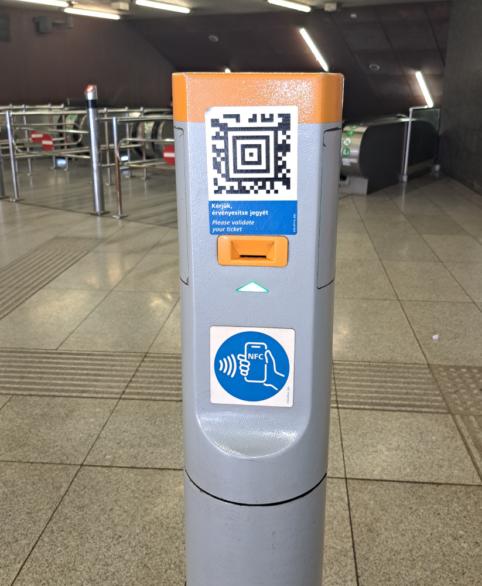
Ticket validation at the metro station for mobile tickets, paper tickets and with NFC
Note that single tickets are only valid for one single, one-way uninterrupted, no-transfer journey, while 30- and 90-minute tickets need to be validated at the beginning of the journey and each time you transfer to another line!
If you purchased a paper 24 or 72-hour Budapest-travelcard you do not need to validate it, as the paper slip already display the time interval in which the pass is valid to be used.
Validating Mobile Tickets
Single tickets, a block of ten tickets (which contains 10 single tickets), 30-minute tickets and 90-minute tickets need to be validated before using the public transportation vehicles. When entering a metro station or boarding a street-level transport vehicle through the front door in Budapest, passengers can validate their mobile tickets using the BudapestGO app. To do so, they simply need to scan the QR code or hold their phone near the NFC-sticker. After scanning, an animated image will appear, which should be presented to the staff. If a ticket inspector requests further verification, passengers can click on the ticket details within the app and display the code found there.
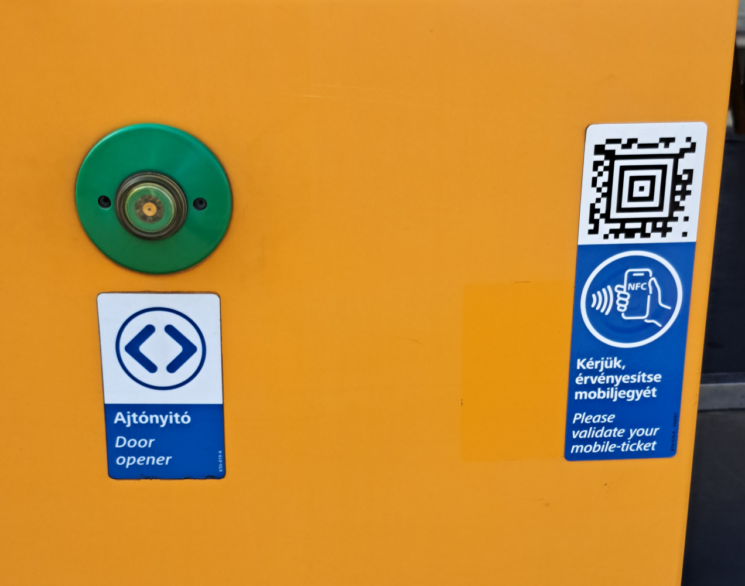
Note that single tickets are only valid for one single, one-way uninterrupted, no-transfer journey, while 30- and 90-minute tickets need to be validated at the beginning of the journey and each time you transfer to another line!
Best deals of Budapest
In case of 24 or 72-hour Budapest-travelcards passengers can validate their mobile tickets using the BudapestGO app when entering a metro station or boarding a street-level transport vehicle through the front door in Budapest. To do so, they simply need to scan the QR code or hold their phone near the NFC-sticker. After scanning, an animated image will appear, which should be presented to the staff. If a ticket inspector requests further verification, passengers can click on the ticket details within the app and display the code found there.
Budapest Pay&GO
The Budapest Pay&GO system offers a convenient and hassle-free way for tourists to navigate the city’s public transportation services. By combining ticket purchase and validation into a single step, this innovative approach saves time and eliminates the need for paper tickets or cash. With Pay&GO devices located at metro stations and on board the 100E Airport Express bus, visitors can easily explore Budapest’s attractions without worrying about ticketing complexities.
To use the Budapest Pay&GO system, passengers can simply tap their Mastercard, Maestro, VISA, or VPay debit, credit, or prepaid cards on the Pay&GO device. Virtual cards registered in digital wallets such as GooglePay, ApplePay, and SamsungPay are also accepted. The device is designed to allow the purchase of up to five tickets at once, making it convenient for groups traveling together. The ticket purchased on the metro line is valid for a single journey on the entire length of the M1, M2, M3, and M4 lines, with transfers between metro lines allowed only if starting the journey on line M1 in the direction of the Deák Ferenc tér transfer hub.
Pay&GO Devices: The Budapest Pay&GO devices are located next to regular ticket validating machines found at the entrance of M1 metro stations. On board the 100E Airport Express bus, the devices are mounted by each door: at the front door on the right side of the driver’s cabin, and on the handrail to the right of the second and third doors. These devices serve multiple purposes, including purchasing and validating tickets, as well as checking previous purchases.
Successful Purchases and Inspections: After a successful purchase, the Pay&GO device’s display will confirm the transaction. No paper ticket or confirmation will be printed. During the journey, passengers can check their purchases on the device under the “Purchase Information” section. In case of a ticket inspection, passengers must touch the bottom of the hand-held checker carried by the inspector with the bankcard or smart device used to buy the ticket. This control process is completely secure, and no payment can be initiated through the inspector’s checker tool.
Troubleshooting: In the event of a failed purchase, the Pay&GO device will display an error message. This may occur if the card is in debt, expired, or if the passenger attempts to buy more than five tickets. If none of these issues apply, passengers should contact their card-issuing bank for further assistance.
Types of Tickets and Passes
Budapest offers a wide range of tickets and passes to suit different travel needs. Some of the most popular options include:
- Single Ticket: Valid for one ride on any mode of public transport.
- Block of 10 Tickets: A discounted option for those who plan to take multiple rides.
- Airport Shuttle Bus Single Ticket: A special ticket for the airport shuttle bus service.
- Travelcards: Available in 24-hour, 72-hour, and other durations, these cards allow unlimited travel on all modes of public transport within the validity period.
- Monthly and 15-Day Passes: Ideal for longer stays or frequent travel, these passes offer unlimited travel for a specified period.
Discounts
Budapest’s public transportation system offers several discounts for specific groups of travelers. Some notable discounts include:
- Children: Children under the age of 6 can travel for free when accompanied by an adult. Those aged 6-14 are also eligible for free travel with the appropriate documentation.
- Seniors: Individuals over the age of 65 can travel for free, regardless of nationality or legal status, by presenting a valid ID.
- Students: Students attending regular or evening courses can purchase discounted student passes by presenting a valid student ID or certificate.
- Disabled Persons: Blind persons, hearing-impaired individuals, and those with severe disabilities are entitled to free travel with the appropriate documentation.
Customer Service Centers
For those who prefer in-person assistance, Budapest has several customer service centers that offer a range of services, including ticket and pass purchases, information on fares and discounts, and general inquiries. These centers are staffed by knowledgeable representatives who can help tourists navigate the public transportation system and make informed decisions about their travel options.
Public Transportation – Day and Night
Budapest has an extensive and efficient public transportation system that includes buses, trams, trolleybuses, and a metro system. The metro system, which consists of four lines, is particularly useful for getting around the city quickly and avoiding traffic jams.
To use public transportation in Budapest, you’ll need to purchase a ticket or a pass. You can buy single-ride tickets from vending machines at metro stations or from kiosks and newsstands. However, if you plan to use public transportation frequently during your stay, it’s more cost-effective to purchase a travel card or a pass, which can be loaded with credit and used for multiple rides.
Another useful tool is the BudapestGo public transportation application (iOS and Android), where you can plan your trips and purchase your tickets as well.
Daytime Public Transportation
Budapest has an extensive and efficient public transportation system that makes it easy to get around the city during the day. The network includes buses, trams, trolleybuses, and metro lines that crisscross the city and provide convenient access to most areas.
Buses are one of the most common forms of public transport in Budapest, with over 200 routes covering the city. The iconic blue buses are modern, clean, and generally run frequently during daytime hours. Many of the main bus routes operate from around 4:30am until 11:00pm.
Budapest’s tram network is also well-developed, with over 30 tram lines running through the city center and beyond. The bright yellow trams are a symbol of Budapest and provide a scenic way to travel while also being an efficient mode of transportation. Most tram lines operate from around 5:00am to 11:00pm.
The metro system in Budapest consists of four lines (M1, M2, M3, and M4) that connect the suburbs to the city center. The metro is fast, reliable, and covers a significant portion of the city. The iconic Line 1, also known as the Millennium Underground, is the oldest metro line in continental Europe. Metro services typically run from around 4:30am until 11:30pm.
To use public transportation in Budapest, you can purchase tickets from machines at metro stations, newsstands, and some tram and bus stops. Alternatively, you can buy a travel card or pass for unlimited travel within a specified time period. Remember to validate your ticket or pass when boarding, as ticket inspectors regularly check for valid tickets and can issue fines for non-compliance.
With its comprehensive daytime public transportation system, exploring Budapest is made easy and convenient for both locals and visitors alike.
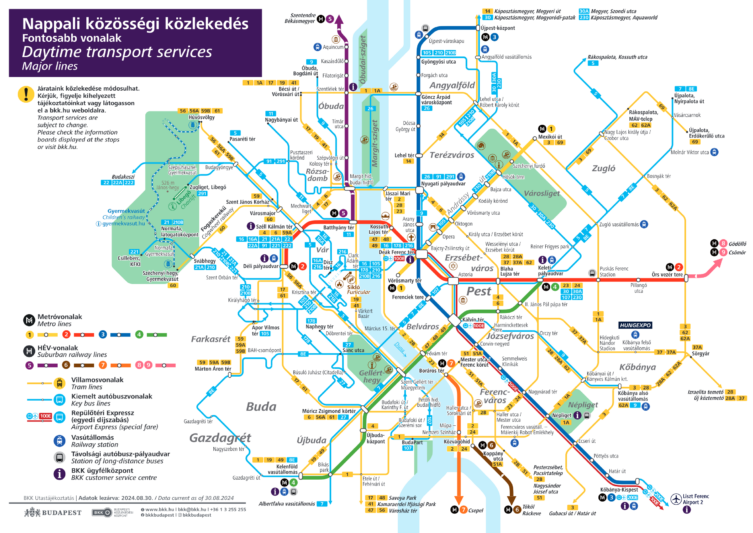
MOL Bubi
The MOL Bubi bike sharing system is a popular mode of transportation for both locals and tourists alike. With over 125 docking stations strategically located throughout the city, you’re never too far from a Bubi bike.
Using the service is incredibly simple. All you need to do is purchase a pass, which can be done online or at any of the docking stations using a credit card. Passes are available for various durations, ranging from a single 30-minute ride to a full week, catering to the needs of both short-term visitors and those staying longer.
Once you have your pass, simply locate the nearest docking station, unlock a bike using the terminal or the MOL Bubi app, and you’re ready to explore. The bikes are sturdy and well-maintained, ensuring a comfortable ride as you weave through Budapest’s charming neighborhoods, parks, and iconic landmarks.
For those concerned about navigating the city’s streets, MOL Bubi provides a handy map on their website and app, highlighting the locations of all docking stations and offering suggested routes for sightseeing.
Metro
Millenium Underground Railway (M1 or yellow line)
Unveiled in 1896, the Millennium Underground Railway (M1 or yellow line) in Budapest is a true marvel of engineering and a testament to the city’s rich history. As the first underground railway in continental Europe and one of the oldest underground railway systems in the world, it predates even the iconic London Underground by two years. This subterranean transportation network was a groundbreaking achievement at the time, and it remains a beloved attraction for visitors to the Hungarian capital.
Stretching for just over 3.7 kilometers (2.3 miles), the Millennium Underground Railway connects the city center,Vörösmarty Square, with the picturesque City Park. Its iconic yellow trains have been ferrying passengers beneath the bustling streets of Budapest for well over a century, offering a unique glimpse into the city’s past while providing a convenient mode of transportation.
As you descend into the underground stations, you’ll be greeted by a charming blend of Art Nouveau and Neo-Renaissance architectural styles. The intricate tile work, ornate lighting fixtures, and intricate details transport you back in time, creating an atmosphere that is both enchanting and nostalgic.
For history buffs and architecture enthusiasts, a ride on the Millennium Underground Railway is an absolute must. Not only does it offer a fascinating glimpse into Budapest’s rich cultural heritage, but it also serves as a reminder of the city’s innovative spirit and its commitment to progress.
Metro Line 2 (Red Line)
One of the best ways to navigate Budapest’s sprawling cityscape is by taking the efficient and convenient M2 metro line, also known as the red line. This underground railway system is a lifesaver for tourists, allowing you to quickly traverse the city and reach many of its top attractions.
The M2 line runs in an east-west direction, connecting the bustling Pest side of the city with the more residential Buda side. It spans a total of 11 stations, including major hubs like Deák Ferenc Square, Kossuth Lajos Square, and Batthyány Square.
For first-time visitors, the Deák Ferenc Square station is a particularly useful starting point. Here, you can easily transfer to other metro lines (M1, M3) and access popular sights like St. Stephen’s Basilica, the Hungarian State Opera House, and the vibrant Váci street.
Another highlight along the M2 line is the Kossuth Lajos Square station, which provides direct access to the iconic Hungarian Parliament Building – a must-see architectural marvel on the Pest side of the Danube River. However, if you want to see the Hungarian Parliament Building from afar, get off at Batthyány Square and after soaking in the beautiful view, you can reach the Buda Castle District with a short walk along the river.
Metro Line 3 (Blue Line)
The M3 line runs in a north-south direction, connecting the bustling city center with the more residential areas on the outskirts of Budapest. It is the longest metro line in the city, spanning a total of 20 stations, including key stops like Deák Ferenc Square, Kálvin Square, and Nyugati Railway Station.
For tourists looking to immerse themselves in Budapest’s rich history, the Deák Ferenc Square station is an ideal starting point. This central hub allows for easy transfers to other metro lines (M1, M2) and provides access to notable landmarks like the Hungarian National Museum, the Great Synagogue, and the famous Andrássy Avenue – a UNESCO World Heritage Site lined with stunning neo-renaissance mansions and high-end boutiques.
Another must-visit stop along the M3 line is Kálvin Square, which is located in the heart of Budapest’s vibrant downtown. Here, you can indulge in delicious local cuisine at the renowned Central Market Hall, or simply soak up the lively atmosphere of the surrounding streets.
Metro Line 4 (Green Line)
As the newest addition to the city’s underground network, metro line M4 offers a smooth and efficient way for tourists to discover some of Budapest’s hidden gems.
The M4 line runs southwest to northeast, connecting the verdant Buda side with the lively Pest side of the city. With 10 stations spanning its route, the green line provides access to a diverse array of attractions, from tranquil parks to vibrant cultural hubs.
One of the most notable features of the Metro Line 4 is its modern design and advanced technology. The stations are spacious, well-lit, and equipped with state-of-the-art amenities such as escalators, elevators, and automatic ticket gates. The trains themselves are sleek, air-conditioned, and offer a smooth, comfortable ride.
One notable stop along the M4 line is the Gellért tér station, situated at the foot of Gellért Hill. This station is perfect for those looking to unwind in the famous Gellért Baths, a stunning Art Nouveau thermal bath complex. Visitors can also take a leisurely stroll up the hill to reach the Citadella.
For a taste of Budapest’s thriving contemporary art scene, hop off at the Fővám tér station and visit the Great Market Hall, a historic indoor market where tourists can sample traditional Hungarian cuisine and shop for unique souvenirs.
The M4 line’s Kálvin tér station is another key stop, connecting passengers to the renowned Hungarian National Museum.
As the Metro Line 4 reaches its eastern terminus at Keleti pályaudvar, passengers can easily transfer to other metro lines or continue their journey to other parts of the city by train or bus.
Trolleybus
The trolleybus system in Budapest has been in operation since 1949 and currently consists of 15 lines, covering a significant portion of the city. These electric vehicles are powered by overhead wires, making them an environmentally friendly alternative to conventional buses. Trolleybuses are not only quieter but also contribute to reducing air pollution in the city.
One of the main advantages of using trolleybuses in Budapest is their extensive coverage of key tourist attractions. Many popular destinations, such as Heroes’ Square, City Park, and St. Stephen’s Basilica is easily accessible via Line 72.
Trolleybuses in Budapest are known for their reliability and frequency, with most lines operating from early morning until late at night. Navigating the trolleybus network is made easier by the clear and user-friendly maps available at stops and online. The BudapestGO application (iOS and Android) is another helpful tool, providing real-time information on trolleybus arrivals and route planning. Furthermore, most stops have digital displays indicating the waiting time for the next trolleybus, ensuring a smooth and stress-free travel experience.
Bus
The Budapest bus network has over 200 bus lines covering the entire city and its surrounding areas, enabling you to easily reach most of Budapest’s famous landmarks, hidden gems, and vibrant neighborhoods. One of the best things about Budapest’s bus system is its frequency. Most bus lines run every 5-15 minutes during peak hours and every 10-30 minutes during off-peak hours, ensuring that you won’t have to wait long for your ride. The buses are modern, clean, and well-maintained, providing a comfortable journey as you explore the city.
Some of the most popular bus lines for tourists include:
- Bus 16: Connects the city center with the Budapest Castle District.
- Bus 100E: Provides a direct connection between the city center and Budapest Ferenc Liszt International Airport.
Budapest’s bus network is an efficient and affordable way to explore the city, connecting you to its numerous attractions, restaurants, and shopping districts. By familiarizing yourself with the system, you’ll be able to make the most of your time in this captivating Hungarian capital.
HÉV Suburban Train
Budapest is connected to the outskirts of the city by the HÉV (Helyiérdekű Vasút) Suburban Train lines. These lines stand out as an efficient and picturesque way to explore the city and its surrounding areas.
The HÉV network consists of five lines, each designated by a letter and a color:
- H5: Batthyány tér – Szentendre
- H6: Közvágóhíd – Ráckeve
- H7: Boráros tér – Csepel
- H8: Örs vezér tere – Gödöllő
- H9: Örs vezér tere – Csömör
These lines connect the city center with charming suburban towns and popular tourist destinations. The H5 line, for example, takes you to the enchanting town of Szentendre, known for its art galleries, museums, and Serbian Orthodox churches. The journey along the Danube River offers stunning views of the surrounding hills and countryside.
The H6 line, on the other hand, runs south along the Danube, linking Budapest with the quaint town of Ráckeve. This line is perfect for those looking to escape the hustle and bustle of the city and enjoy a more laid-back atmosphere.
For a taste of local life, take the H7 line to Csepel, a residential area with a rich industrial heritage. The H8 line connects the city with Gödöllő, home to the magnificent Royal Palace, once a favorite retreat of Empress Elisabeth of Austria (Sissi).
Using the HÉV is simple and convenient. Tickets can be purchased at the stations or onboard from the ticket inspector. Be sure to validate your ticket before boarding the train. The HÉV lines operate frequently, with trains running every 10-20 minutes during peak hours and every 30-60 minutes during off-peak hours.
As a tourist, the HÉV offers a unique perspective on Budapest and its surroundings. The trains provide a comfortable and affordable way to explore beyond the city center and discover hidden gems.
Night Transport: Public Transport After Dark
Budapest is a city that truly comes alive after sunset, with its vibrant nightlife scene offering everything from ruin pubs and trendy bars to world-class clubs and live music venues. While the city’s energy may be electric at night, getting around can be a concern for visitors unfamiliar with the area. Fortunately, Budapest’s public transport system operates around the clock, ensuring that you can explore the city’s nocturnal delights without worrying about how to get back to your accommodation.
The Budapest Public Transport Company (BKK) runs a comprehensive night transportation network, consisting of trams, buses, and metro lines. The night services, known as “Night Buses” and “Night Trams,” operate from approximately 11 PM until the early morning hours, typically until around 4 AM. These routes cover most of the city’s popular nightlife districts, including the iconic ruin pubs in the Jewish Quarter, the lively bars and clubs along the Danube, and the bustling party scene in Pest’s downtown area.
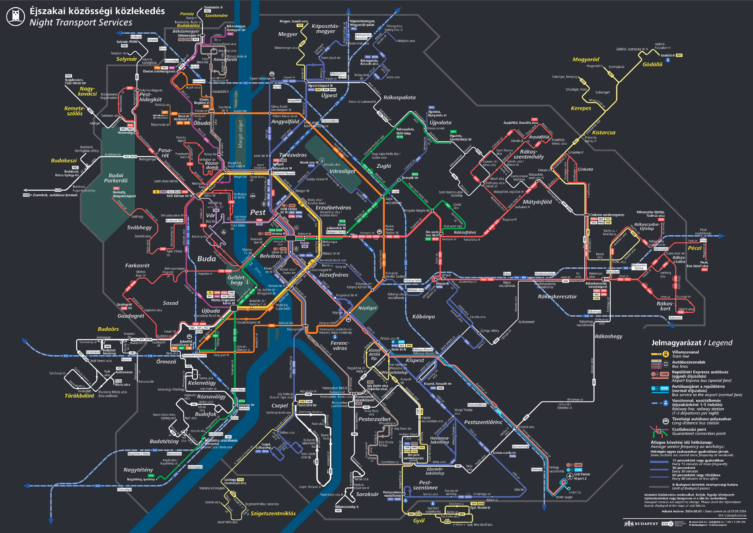
One of the advantages of using public transport at night is the convenience and affordability it offers. With a single ticket or pass, you can hop on and off various modes of transport, allowing you to explore multiple neighborhoods without the hassle of finding parking or navigating unfamiliar streets. Additionally, the night services run at regular intervals, ensuring that you won’t have to wait too long for your ride.
To make the most of your nighttime adventures in Budapest, it’s recommended to familiarize yourself with the night transportation routes and schedules. The BKK website and mobile app provide up-to-date information on timetables, route maps, and any service disruptions or changes. Additionally, many hotels and hostels can provide guidance on the best ways to navigate the city’s public transport system at night.






